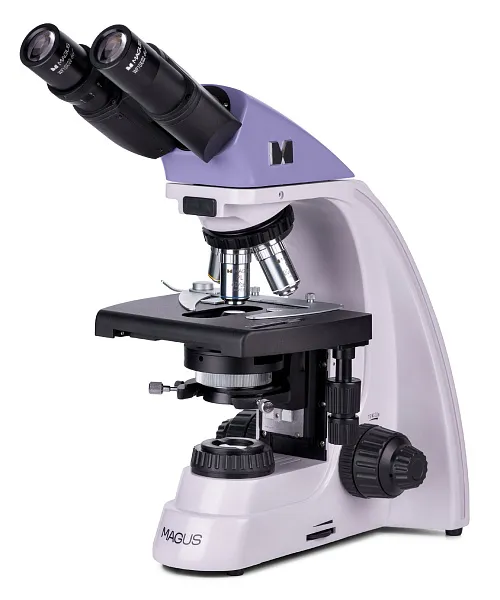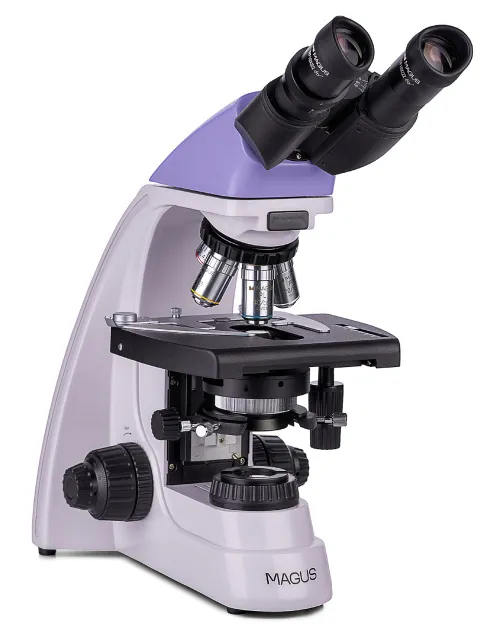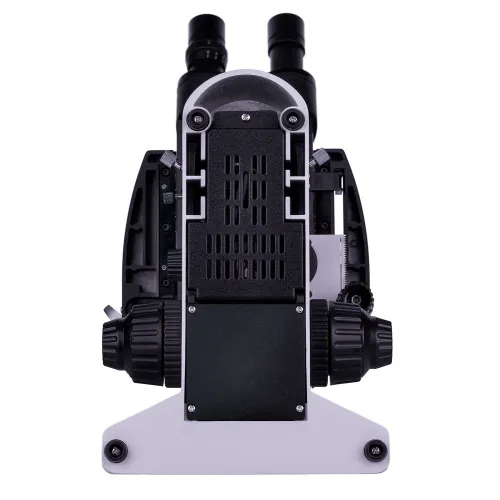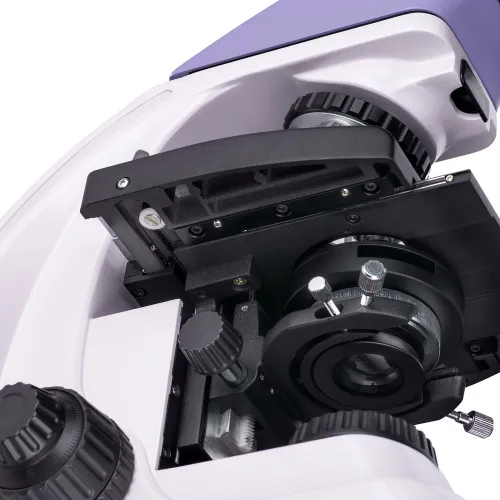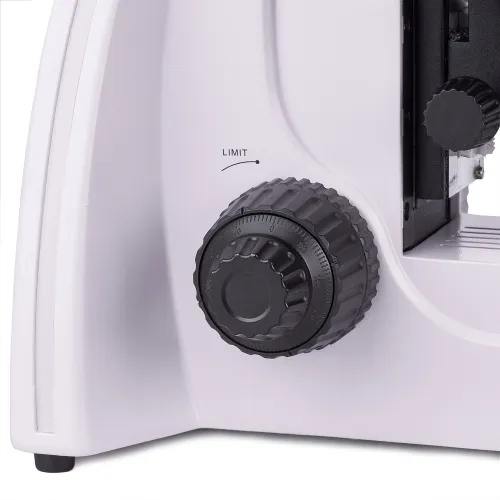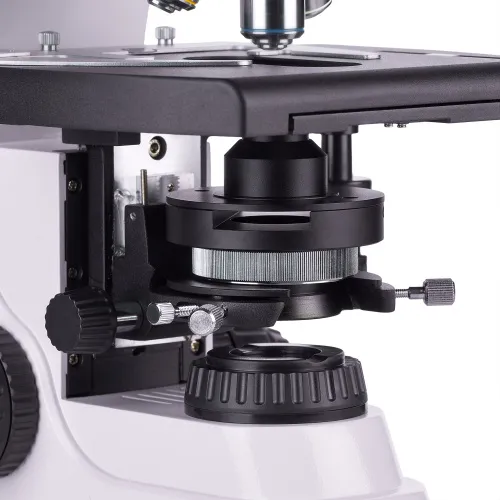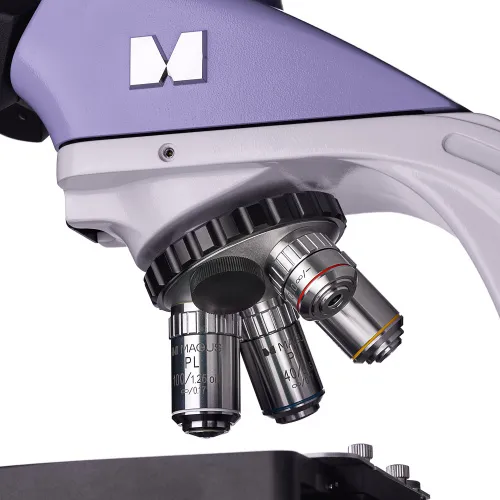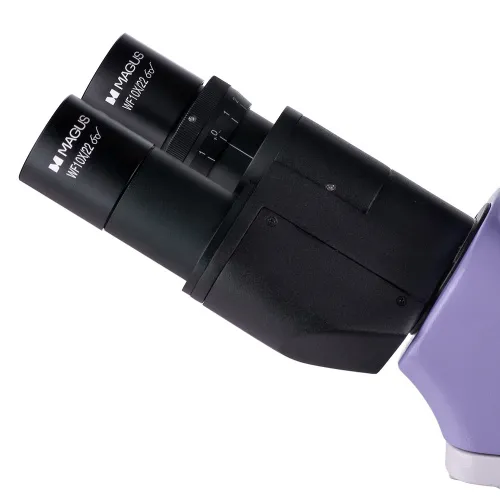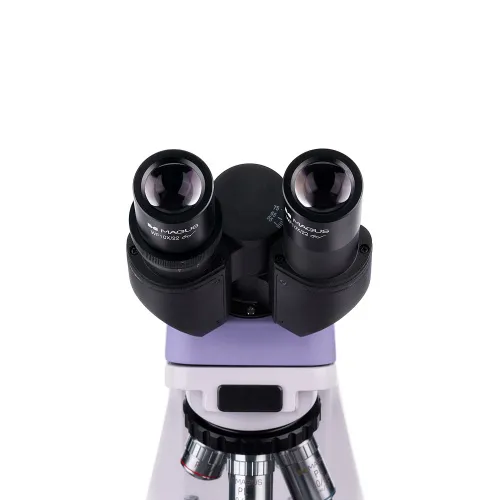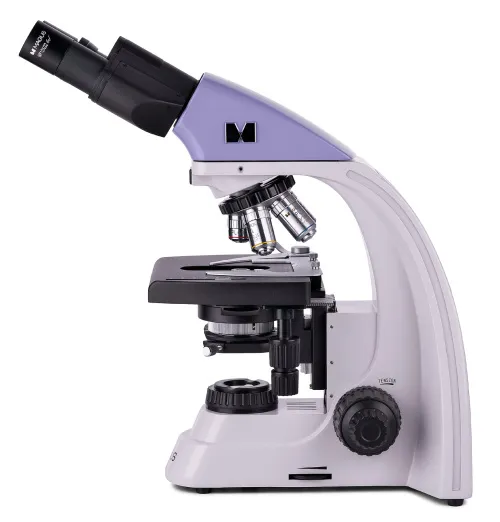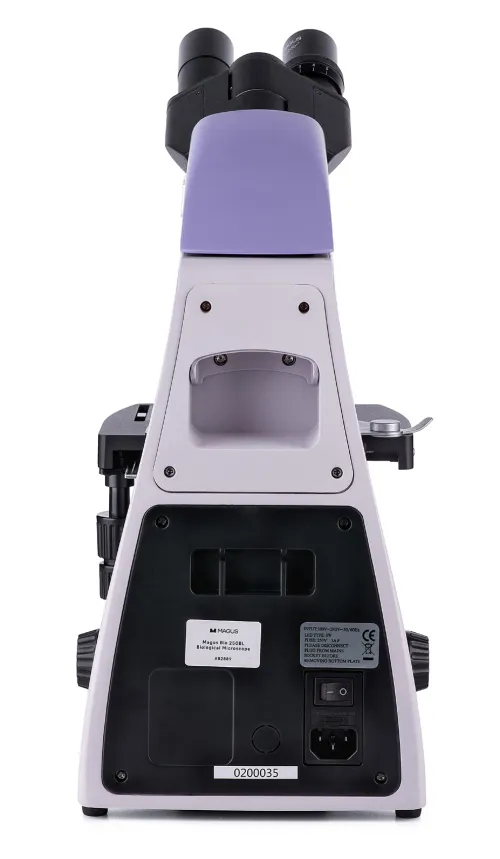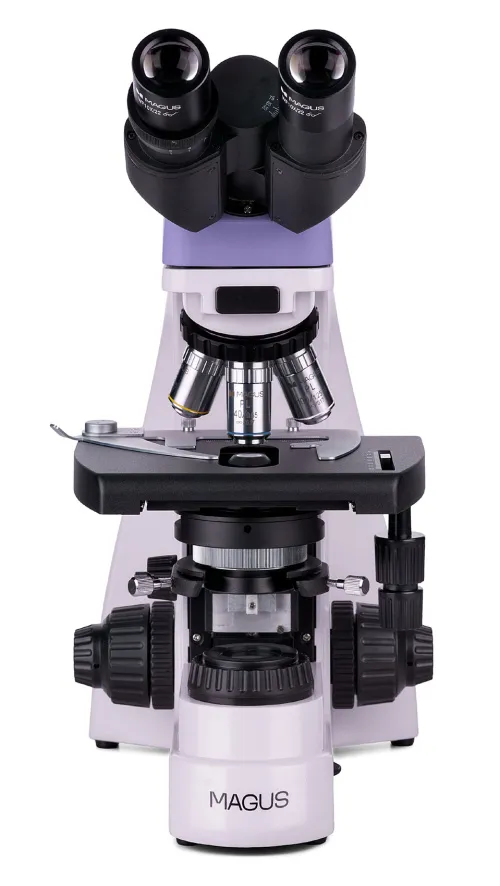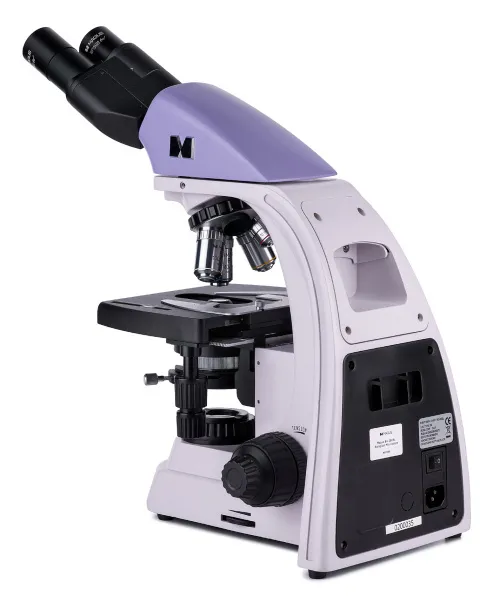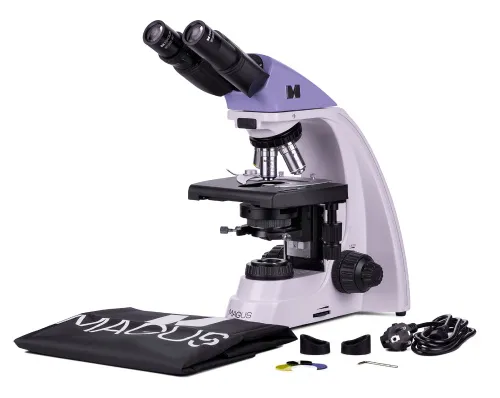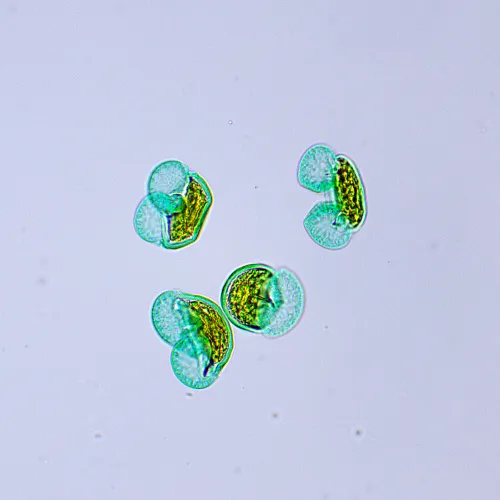MAGUS Bio 250BL Biological Microscope
Magnification: 40–1000x. Binocular head, infinity plan achromatic objectives, 3W LED
| Product ID | 82889 |
| Brand | MAGUS |
| Warranty | 5 years |
| EAN | 5905555018041 |
| Package size (LxWxH) | 43x27x63 cm |
| Shipping Weight | 10 kg |
The MAGUS Bio 250BL microscope can be used for laboratory work, scientific research, and student teaching. It is designed to observe thin sections and smears of biological samples in transmitted light. The main method of observation is brightfield, but it is also possible to use darkfield, polarization, and phase contrast techniques (with additional accessories).
Optics
The microscope comes with 4 infinity plan achromatic objectives. They produce well-detailed images with minimal distortion. The objectives are mounted in the revolver, which is designed to hold 5 objectives at a time, with one slot remaining free. It allows you to use an additional objective lens to achieve extra magnification within the magnification range. The revolving nosepiece is oriented toward the interior.
The position of the microscope head is comfortable for long work. The height of the eyepieces can be adjusted by rotating the eyepiece tubes 360°. The left tube has a diopter adjustment ring and a digital camera can also be mounted in it (camera not included).
The microscope magnification range is from 40x to 1000x. The upper range limit can be increased by adding additional eyepieces.
Illumination
LED lights allow you to change brightness without changing the color temperature. The LED bulb has a lifespan of 50,000 hours and a 3W capacity. The illumination requires a 220V power supply to operate.
The illumination system also includes an Abbe condenser with an aperture diaphragm and a slider slot. It is possible to place either a darkfield slider or a phase slider in the slot. You will then be able to switch between different research techniques more quickly. The microscope is also equipped with a field diaphragm. Therefore, you can use the Köhler illumination method.
Stage and focusing mechanism
The main mechanical feature of the microscope is the slide without a positioning rack. It is easy to operate and its mechanism requires less space. The sample is moved via a removable mechanical attachment.
The focusing knobs are located at the bottom, where they are more convenient to use – you do not have to hold your hands in the air, thereby allowing you to adopt a relaxed posture while working. The coarse focusing mechanism has a lock knob and tension adjustment. There is a fine focusing knob. The knobs are coaxially located on both sides of the microscope body.
Accessories
If the power of the microscope is insufficient, it can be increased with additional accessories. The MAGUS Bio 250BL microscope is available with optional eyepieces and objectives, darkfield, and phase contrast and polarization devices as well as digital cameras and calibration slides.
Key features:
- Binocular microscope, digital camera is installed in a tube with diopter adjustment
- Eyepiece adjustment to fit the height of the observer by rotating the tubes by 360°
- Observations in transmitted light, illuminator is 3-watt long-life LED
- Köhler illumination setup thanks to a field diaphragm and a center-adjustable and height-adjustable Abbe condenser with aperture diaphragm
- Option to install darkfield and phase contrast sliders in a condenser slot
- Optional accessories to improve microscope performance
The kit includes:
- Base with a power input, transmitted light source, focusing mechanism, stage, condenser mount, and revolving nosepiece
- Abbe condenser
- Binocular head
- Infinity plan achromatic objective: 4x/0.10
- Infinity plan achromatic objective: 10x/0.25
- Infinity plan achromatic objective: 40x/0.65 (spring-loaded)
- Infinity plan achromatic objective: 100x/1.25 oil (spring-loaded)
- Eyepiece 10x/22mm with a long eye relief (2 pcs.)
- Eyecup (2 pcs.)
- Filter (4 pcs.)
- Bottle of the immersion oil
- AC power cord
- Dust cover
- User manual and warranty card
Available on request:
- 10x/22mm eyepiece with scale
- 12.5x/14mm eyepiece (2 pcs.)
- 15x/15mm eyepiece (2 pcs.)
- 20x/12mm eyepiece (2 pcs.)
- 25x/9mm eyepiece (2 pcs.)
- Infinity plan achromatic objective: 20x/0.40
- Infinity plan achromatic objective: 60x/0.80 (spring-loaded)
- Phase-contrast device
- Phase slider
- Darkfield condenser NA 0.9
- Oil darkfield condenser NA 1.36–1.25
- Darkfield slider
- Polarization devices
- Digital camera
- Calibration slide
- C-mount adapter
- Adapter Ring
- LCD Monitor
| Product ID | 82889 |
| Brand | MAGUS |
| Warranty | 5 years |
| EAN | 5905555018041 |
| Package size (LxWxH) | 43x27x63 cm |
| Shipping Weight | 10 kg |
| Type | biological, light/optical |
| Microscope head type | binocular |
| Head | Gemel head (Siedentopf, 360° rotation) |
| Head inclination angle | 30 ° |
| Magnification, x | 40 — 1000 |
| Magnification, x (optional) | 40–1200/1250/1500/1600/2000/2500 |
| Eyepiece tube diameter, mm | 30 |
| Eyepieces | 10х/22mm, eye relief: 10mm (*optional: 10x/22mm with scale, 12.5x/14; 15x/15; 20x/12; 25x/9) |
| Objectives | infinity plan achromatic: 4x/0.10; 10x/0.25; 40xs/0.65; 100xs/1.25 (oil); parfocal distance: 45mm (*optional: 20x/0.40; 60хs/0.80) |
| Revolving nosepiece | for 5 objectives |
| Working distance, mm | 21 (4x); 5 (10x); 0.66 (40xs); 0.36 (100xs); 8.8 (20x); 0.465 (60xs) |
| Interpupillary distance, mm | 48 — 75 |
| Stage, mm | 180x150 |
| Stage moving range, mm | 75/50 |
| Stage features | two-axis mechanical stage, without a positioning rack |
| Eyepiece diopter adjustment, diopters | ±5 (on the left tube) |
| Condenser | Abbe condenser, N.A. 1.25, center-adjustable, height-adjustable, adjustable aperture diaphragm, a slot for a darkfield slider and phase contrast slider, dovetail mount |
| Diaphragm | adjustable aperture diaphragm, adjustable iris field diaphragm |
| Focus | coaxial, coarse focusing (21mm, 39.8mm/circle, with a lock knob and tension adjusting knob) and fine focusing (0.002mm) |
| Illumination | LED |
| Brightness adjustment | ✓ |
| Power supply | 220±22V, 50Hz, AC network |
| Light source type | 3W LED |
| Light filters | yes |
| Operating temperature range, °C | 5...+35 |
| Ability to connect additional equipment | phase contrast device (condenser and objectives), darkfield condenser (dry or oil), polarization devices (polarizer and analyzer) |
| User level | experienced users, professionals |
| Assembly and installation difficulty level | complicated |
| Application | laboratory/medical |
| Illumination location | lower |
| Research method | bright field |
| Pouch/case/bag in set | dust cover |
| Weight, kg | 8 |
| Dimensions, mm | 200x436x400 |
We have gathered answers to the most frequently asked questions to help you sort things out
Find out why studying eyes under a microscope is entertaining; how insects’ and arachnids’ eyes differ and what the best way is to observe such an interesting specimen
Read this review to learn how to observe human hair, what different hair looks like under a microscope and what magnification is required for observations
Learn what a numerical aperture is and how to choose a suitable objective lens for your microscope here
Learn what a spider looks like under microscope, when the best time is to take photos of it, how to study it properly at magnification and more interesting facts about observing insects and arachnids
This review for beginner explorers of the micro world introduces you to the optical, illuminating and mechanical parts of a microscope and their functions
Short article about Paramecium caudatum - a microorganism that is interesting to observe through any microscope

